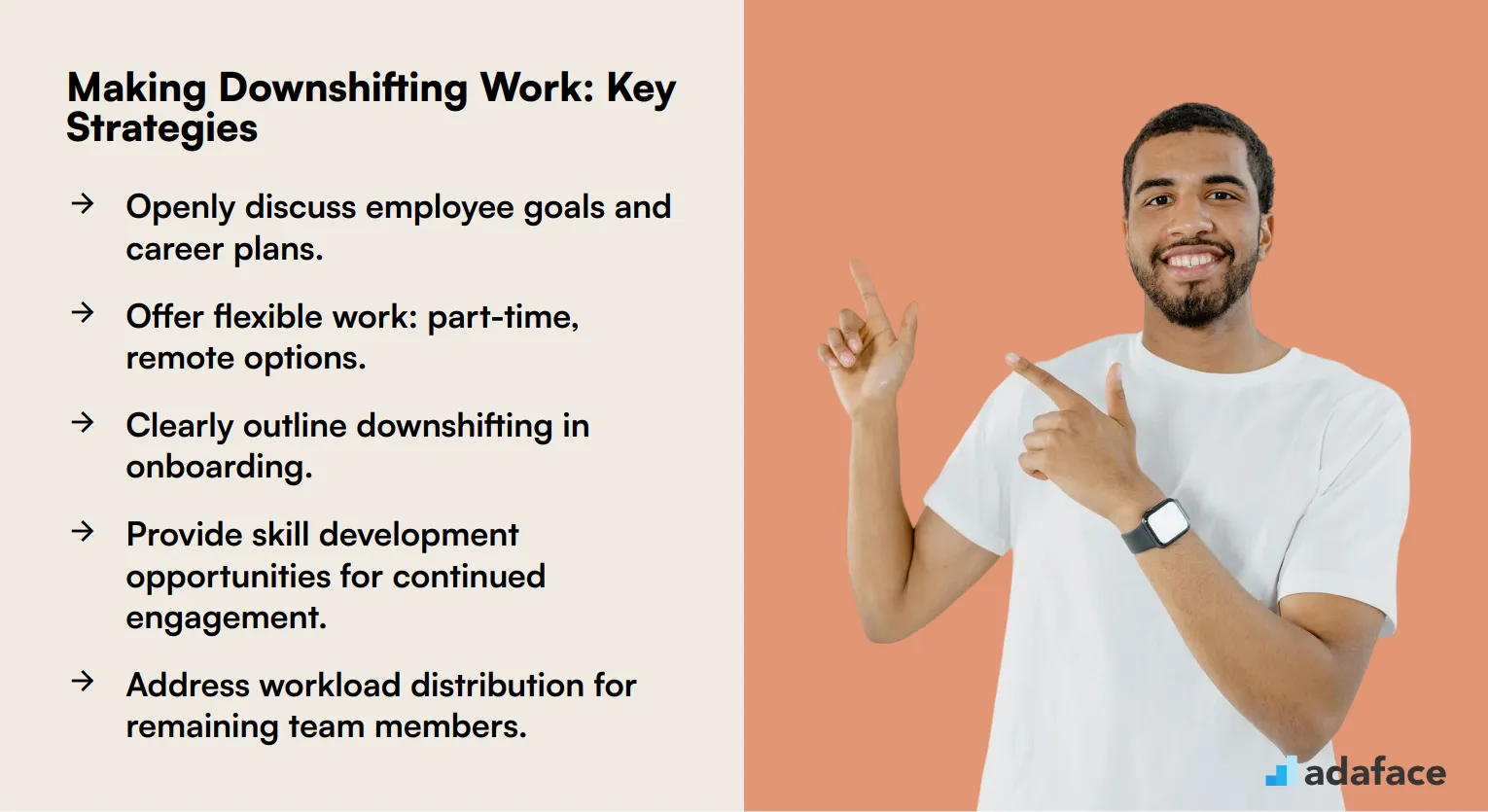Downshifting in the workplace refers to the conscious decision by employees to reduce their work hours or responsibilities. This trend is gaining traction as more individuals prioritize work-life balance and personal fulfillment over traditional career advancement.
For recruiters, understanding downshifting is crucial in today's dynamic job market. Supporting employees who choose to downshift can enhance team morale and retention. Learn how to navigate this shift by exploring inclusive hiring practices.
Table of contents
What is Downshifting in the Workplace?
Downshifting in the workplace refers to the conscious decision by employees to reduce their work hours or responsibilities to achieve a better work-life balance. It is not about slacking off but rather about prioritizing personal well-being over career advancement.
Employees who choose to downshift often seek more time for family, personal interests, or mental health. It can be a response to job stress or burnout, aiming to maintain productivity without the constant pressure of climbing the corporate ladder.
For recruiters and hiring managers, understanding downshifting is important when assessing experience gaps in candidates' resumes. Recognizing this trend can help in creating roles that accommodate flexible schedules or reduced responsibilities.
Downshifting can also influence team dynamics and overall workplace culture. By supporting employees in their decision to downshift, companies can foster a more inclusive and supportive environment.
Reasons Employees Choose to Downshift
Employees choose to downshift for various reasons, often seeking a better work-life balance. The modern workplace can be demanding, leading individuals to prioritize personal well-being over career advancement.
Some employees downshift to focus on family commitments or personal development. This decision can stem from the need to be more present for family or to pursue hobbies and interests that were previously sidelined due to work pressures.
Health concerns also play a significant role in the decision to downshift. Chronic stress or burnout can prompt employees to seek roles with reduced hours or responsibilities to maintain their mental and physical health.
Career satisfaction is another factor, as some employees may seek roles that align more closely with their values or passions. This shift can enhance job satisfaction and lead to a more fulfilling career path.
Lastly, the desire for flexibility in work arrangements can drive employees to downshift. Remote work opportunities or flexible schedules can be more appealing, allowing individuals to better manage their time and responsibilities.
The Impact of Downshifting on Teams
Downshifting can significantly influence team dynamics, often leading to a shift in workload distribution. This change can result in either positive or negative outcomes, depending on how the team adapts to the new pace of work.
When a team member downshifts, it can create an opportunity for others to take on new responsibilities and develop their skills. This can foster an environment of growth and learning, enhancing the overall team dynamics.
However, if not managed properly, downshifting can lead to increased stress for remaining team members who might need to pick up the slack. This can cause friction and decreased morale, impacting productivity and job satisfaction.
To mitigate negative impacts, clear communication and role adjustments are crucial. Ensuring that all team members are on the same page can help maintain balance and prevent any potential disruptions in workflow.
Ultimately, the impact of downshifting on teams hinges on effective management and the ability to adapt to new dynamics. By fostering a supportive environment, teams can turn downshifting into an opportunity for positive change.
How to Support Employees Who Downshift
Supporting employees who choose to downshift requires a thoughtful approach to ensure their continued engagement and satisfaction. It's important to foster an environment where employees feel comfortable expressing their desire to take on less responsibility without fear of judgment or penalty.
Start by having open conversations with employees about their goals and how downshifting fits into their career plans. This can be done through regular check-ins and performance reviews where employees can voice their needs and aspirations.
Offering flexible work arrangements, such as part-time schedules or remote work options, can be beneficial for those looking to downshift. These arrangements allow employees to maintain a work-life balance that suits their personal circumstances.
Ensure that the downshifting process is clearly outlined in your employee-onboarding-process and communicated transparently to everyone in the organization. This helps in setting expectations and maintaining transparency across the board.
Finally, provide opportunities for employees to continue developing their skills, even if they are taking on less demanding roles. This can include access to training programs or mentorship opportunities to keep them engaged and motivated.

Challenges of Managing Downshifting Employees
Managing downshifting employees presents unique challenges for recruiters and HR professionals. It requires a delicate balance between respecting the employee's choice and maintaining productivity within the team.
One of the main challenges is ensuring that the workload is evenly distributed among team members. When an employee downshifts, it often means their responsibilities need to be reassigned, which can lead to increased pressure on remaining team members.
Communication is another critical hurdle. HR professionals must ensure that the reasons for downshifting are clearly understood and that expectations are managed appropriately to prevent misunderstandings.
There is also the risk of setting a precedent within the organization. If not handled carefully, downshifting can lead to more employees seeking similar arrangements, which might not be feasible for the company in the long run.
Lastly, maintaining employee engagement and motivation can be tricky. Downshifting employees might feel disconnected from their previous roles, and HR must find ways to keep them integrated into the team, perhaps through targeted training or talent-rediscovery.
Tips for Creating a Downshifting-Friendly Culture
Creating a downshifting-friendly culture begins with open communication and understanding what downshifting means for your organization. Encourage employees to share their thoughts on work-life balance and how they envision their roles evolving in a more flexible environment.
Foster an atmosphere where employees feel comfortable discussing their needs and preferences without fear of judgment. This can be achieved by training managers to recognize and support diverse work styles and preferences, which can be explored through talent acquisition tools.
Consider implementing flexible work arrangements, such as remote work options or adjusted work hours, to accommodate different lifestyles. By providing these options, you demonstrate a commitment to employee well-being and create an inclusive environment that values individual contributions.
Recognize and celebrate small victories in creating a downshifting-friendly culture, as these can boost morale and encourage more employees to embrace the change. Share success stories and feedback to highlight the positive impact of downshifting on both the organization and its employees.
Lastly, regularly assess the effectiveness of your downshifting strategies and be open to making adjustments. This ongoing evaluation ensures that your organization remains responsive to the evolving needs of its workforce, enhancing overall job satisfaction and productivity.
Embracing Downshifting in the Modern Workplace
Downshifting is becoming a reality in today's work environment, and it's important for HR professionals and managers to understand and adapt to this trend. By recognizing the reasons behind downshifting and its impact on teams, organizations can create supportive policies and cultures that benefit both employees and the company.
Implementing strategies to support downshifting employees and addressing the challenges that come with it can lead to a more flexible and inclusive workplace. By fostering a downshifting-friendly culture, companies can attract and retain talented individuals who seek better work-life balance, ultimately contributing to a more engaged and productive workforce.
As the workplace continues to evolve, embracing downshifting as a valid career choice can help organizations stay competitive and responsive to changing employee needs. By staying informed and open-minded about downshifting, HR professionals and managers can navigate this trend successfully and create a more adaptable and resilient organization.
Downshifting FAQs
Downshifting involves employees choosing to reduce their work hours or responsibilities to achieve a better work-life balance.
Employees may downshift to focus on personal growth, reduce stress, or spend more time with family and hobbies.
Recruiters can support by offering flexible work arrangements and understanding the individual needs of employees who choose to downshift.
Managers may face challenges in workload distribution and maintaining team productivity when employees downshift.
Creating a downshifting-friendly culture involves promoting work-life balance, offering flexible hours, and encouraging open communication.

40 min skill tests.
No trick questions.
Accurate shortlisting.
We make it easy for you to find the best candidates in your pipeline with a 40 min skills test.
Try for freeRelated terms



